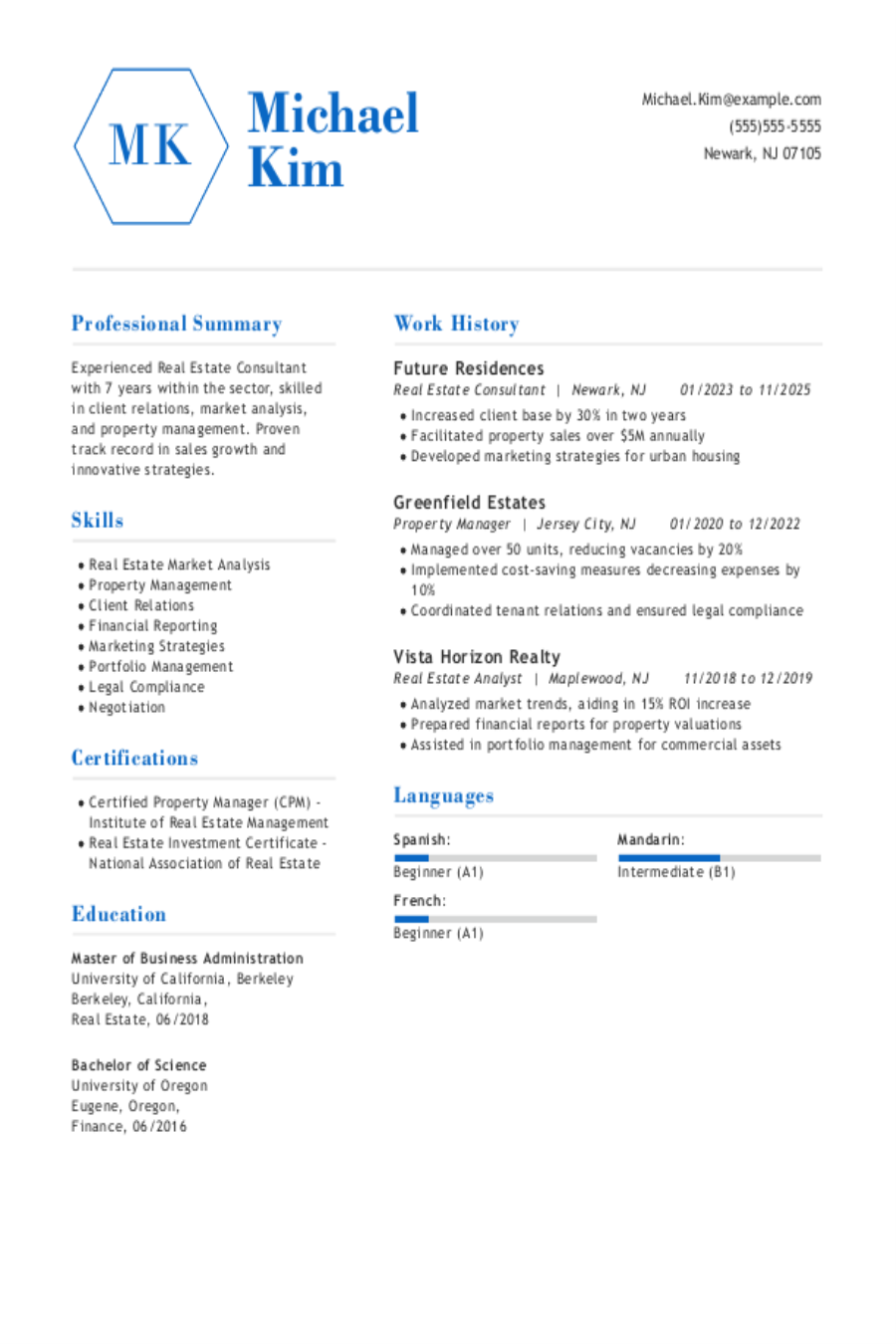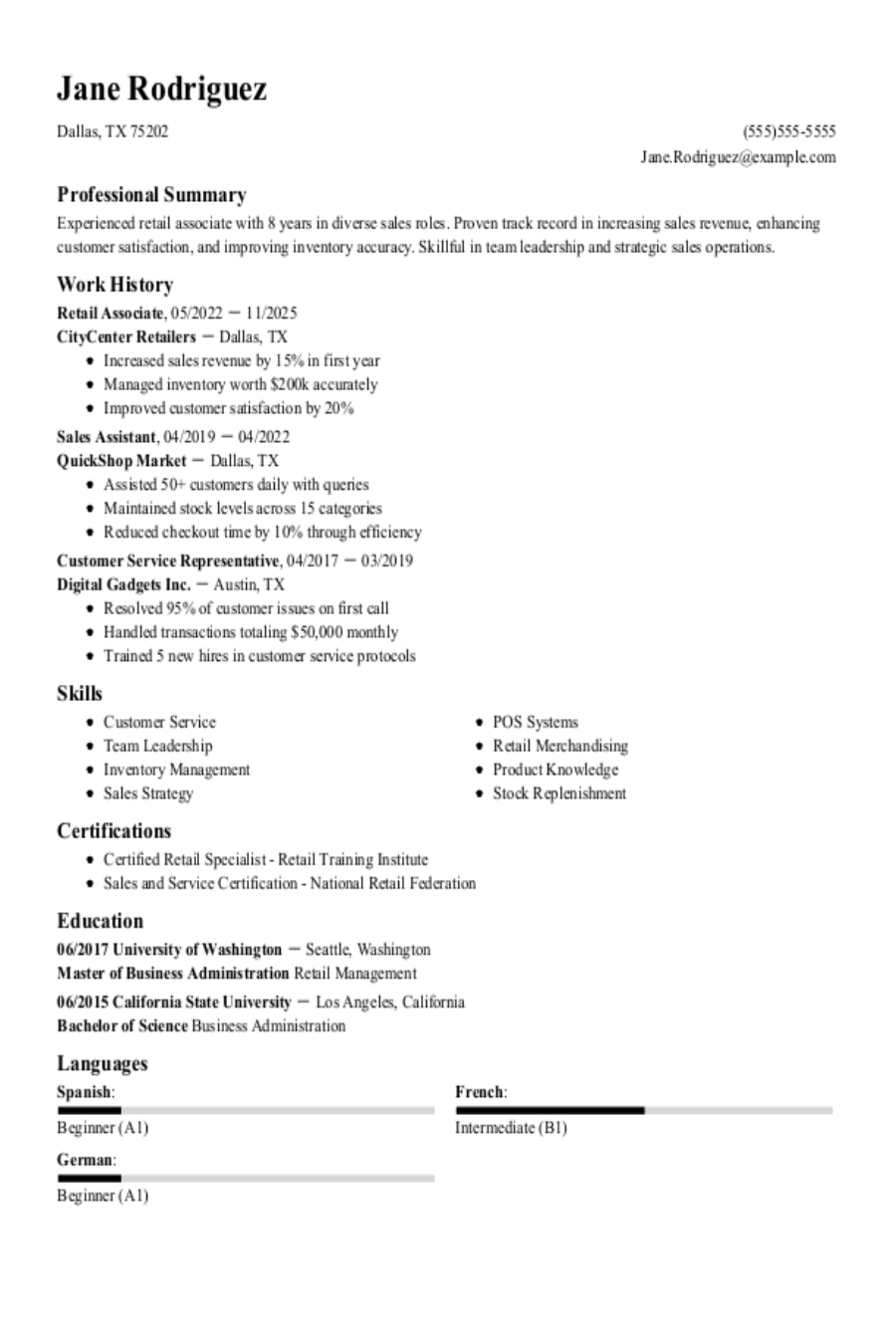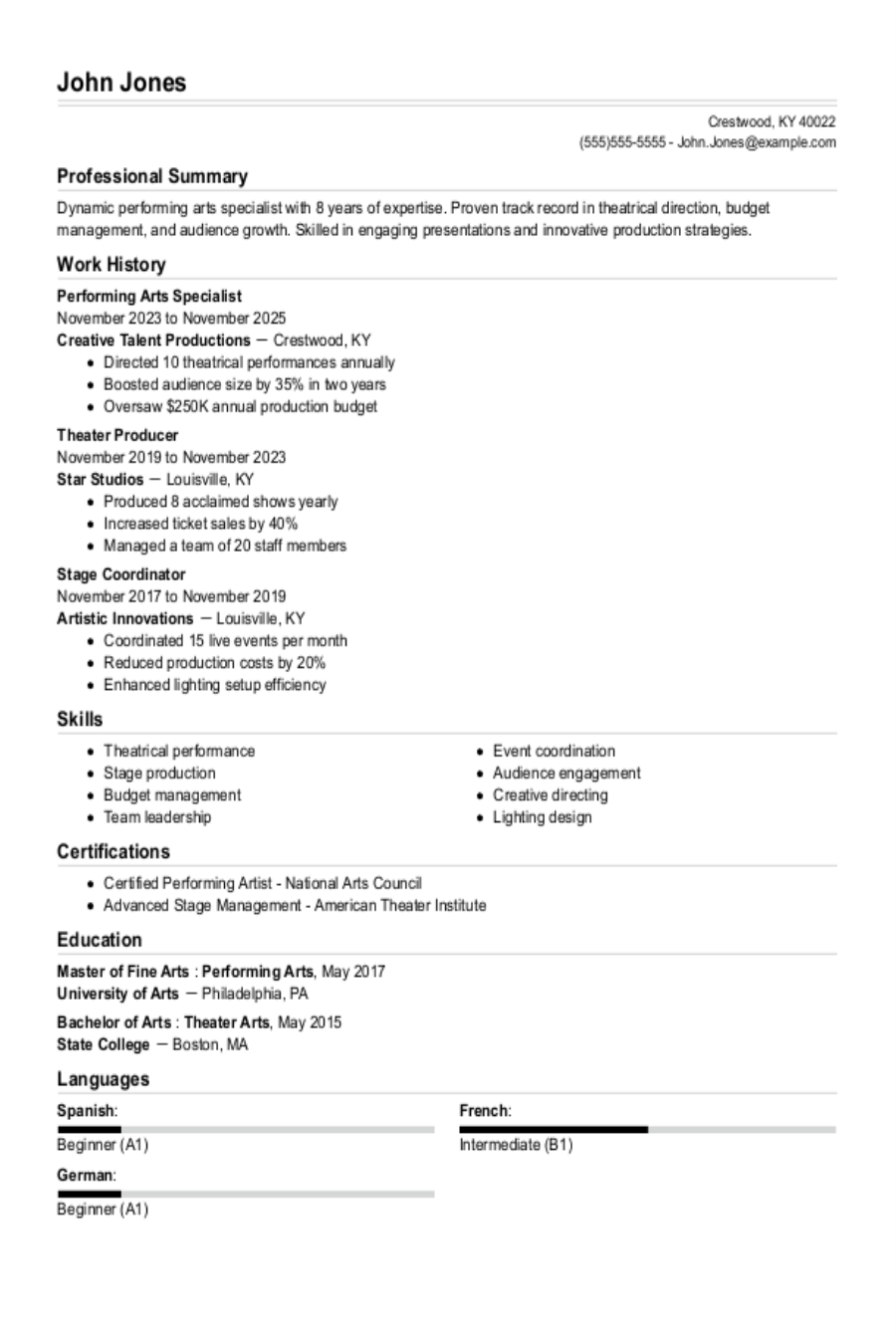Table of contents
Active listening skills are a key ability for the modern workplace. A worker who is demonstrating strong listening skills on a consistent basis is a worker who is proving that they can be counted on by employers, coworkers, and team members.
But what does active listening mean? And how can you write a resume that shows employers that you're open-minded, thoughtful, and collaborative? Our guide, with specific examples, will help with that.
Our guide includes:
- An active listening skills definition to help you understand why they matter
- Examples of specific skills to use on your resume
- Tips to help you improve as a collaborator
Need a resume where you can show off your active listening skills? Try our AI Resume Builder. This tool offers customizable content suggestions, expert tips, and formatting help, so you can create an application-ready resume in just a few minutes.
What Are Active Listening Skills?
First, what does active listening mean? Active listening is deeper than just hearing the words that someone says to you. It means metabolizing their meaning and engaging with the speaker. If you aren't giving your full attention to the speaker, then you aren't practicing active listening.
So, by definition, active listening skills help you understand, engage with, and analyze the meaning of communications. They are deeply tied to your interpersonal skills and your communication skills.
How do you know if you're listening actively? Here are some of the basic principles of active listening:
- Attention: Active listening means giving your full and undivided attention to the speaker. Practice mentally engaging with what's being said and try to check in with yourself when your attention is taken away by internal distractions.
- Focus on listening, not replying: Formulating a thoughtful response is an important way to engage with a discussion, but if you're more focused on your response than the speaker, you're not actively listening. Let your ideas and thoughts come up naturally, but try to avoid focusing on them until it's your turn to speak.
- Body language: Give the speaker signals of your attention with appropriate body language. Nodding, leaning into the speaker, and appropriate eye contact will help show the speaker that you're interested and engaged with the topic.
- Thoughtful responses: While your listening time should be listening-focused, when it is your turn to speak, responding with a thoughtful, empathetic response is key to productive discussion.
Why Do Active Listening Skills Matter on a Resume?
Active listening skills are crucial for your resume. Whether you're a project manager or a school principal, the ability to understand directions, collaborate with others, and synthesize information is an essential skill set.
Employers are interested in candidates who display critical soft skills because they're not easy to teach. While you can develop your technical expertise on the job, strong working habits are formed throughout your life experiences and education.
Employers can't count on their training processes to make you an active listener, so demonstrating that you have this skill set can be a huge asset.
30+ Active Listening Skills Examples to Include on Your Resume
Your resume skills section is a great opportunity to demonstrate what a strong active listener you are. To help you get started, here's a list of active listening skills examples that you can focus on in your resume.
To make them easier to digest, we've broken this skill set down into three categories.
Attention
As we discussed above, the most important aspect of active listening is attention. In fact, that's largely what sets active listening apart from regular old listening. When you listen actively, you give the speaker your full attention and focus your thoughts on what they're saying.
Here are some attention skills for your resume:
- Attentiveness
- Focus
- Engagement
- Alertness
- Concentration
- Absorption
- Involvement
- Attentive silence
- Respect
Context is important. Just listing "respect" in your resume's skills section is unhelpful at best and a bit confusing at worst. Integrate active listening skills throughout your resume, including measurable results and outcomes to show employers what these skills mean to you and how you apply them.
Understanding
The next category is comprehension. It isn't enough to just pay attention to what is being said. You need to do the mental work of understanding, analyzing, and synthesizing the information presented to you. This will allow you to act on it in ways that demonstrate that you've been truly listening.
Understanding skills for your resume:
- Comprehension
- Empathy
- Perspective-taking
- Sensitivity
- Insight
- Accuracy
- Interpretation
- Analysis
- Synthesis
- Critical thinking
- Clarity
- Reflective listening
Response
Finally, the objective of active listening is action. You should be prepared to respond to new information thanks to the attention you gave it and the comprehension you employed. These key skills will help you respond to information thoughtfully.
Response skills to help you put new information into action:
- Feedback
- Questioning
- Communication
- Acknowledgment
- Validation
- Summarization
- Paraphrasing
- Clarification
- Encouragement
- Confirmation
- Encapsulation
- Affirmation
How to List Active Listening Skills on Your Resume
Now that we've equipped you with a solid set of active listening skills to focus on, let's look at how best to use them on your resume so that employers can see how thoughtful and attentive you are.
Step #1
Start by examining the job description
No matter the role, the job listing is always the best place to start when preparing your resume. Look for keywords that indicate which active listening skills the employer is looking for in their ideal candidate. Integrate the key skills you find in the job ad into your resume so recruiters can see you're an ideal fit.
For instance, consider this job listing:
Our ideal candidate for the role of sales associate is someone who can:
- Greet and assist customers in a friendly and professional manner.
- Actively listen to customers to understand their preferences, interpret their needs, and recommend products.
- Provide product demonstrations and answer questions about features and benefits.
- Validate customer concerns and address negative feedback promptly and efficiently.
- Meet and exceed sales targets and goals.
The bolded keywords represent some of the active listening skills that a candidate might benefit from emphasizing on a resume for this role.
Using active listening skills from the job listing on your resume not only positions you as a perfect fit for the role but also helps you pass through applicant tracking systems (ATS) with ease.
Step #2
Feature active listening skills in your skills section
Alongside hard skills specific to your field, your skills section should feature some more subtle soft skills that display your well-roundedness. This is a perfect opportunity to highlight a few of your most important active listening skills.
Sample skills section featuring active listening skills:
- Attentive and focused listener, able to concentrate on complex discussions and absorb key details
- Strong analytical and critical thinking skills to interpret and synthesize information
- Empathetic communicator skilled in perspective-taking and providing thoughtful feedback
Step #3
Integrate active listening skills throughout your resume
Your skills section isn't the only place where you can show off your active listening skills. Your work history is a great place to show how you've applied those skills in real-life scenarios.
Consider this example:
Sales Associate
XYZ Retail Store, City, State
January 2020 – July 2025
- Interpreted customers' needs and preferences to recommend appropriate products, resulting in a 15% increase in sales.
- Demonstrated active listening skills by attentively understanding customers' inquiries and providing accurate information.
- Utilized effective communication skills to interact with customers, address their concerns, and build rapport.
- Answered questions about products, features, and pricing, demonstrating strong product knowledge and attention to detail.
The work history section isn't the only place where you can do this, either. Your resume profile offers a valuable opportunity to highlight some of the most important keywords on your resume at the very top. These are the first active listening skills that employers will likely see, so pick the ones that you think are the most relevant to the role and your expertise.
If you're an entry-level candidate at the beginning of your career journey, consider using a functional resume format to highlight your active listening skills without relying on the work experience that you haven't earned yet.
Step #4
Don't forget to include active listening skills in your cover letter
Your cover letter is essential to your job search. It allows you to expand on your resume and express your enthusiasm for the role. It also gives you another chance to demonstrate some active listening skills. In your cover letter, you should explain how your skills have allowed you to achieve impressive results.
For help getting started, explore cover letter examples that feature strong skills sections full of active listening skills.
Example cover letter paragraph featuring active listening skills:
In my previous role, I made it a point to truly listen to clients, staying attentive and focused so I could understand not just their immediate needs but the bigger picture. By combining empathy with clear analysis, I was able to offer thoughtful solutions that built trust and respect. I believe open communication and genuine engagement are essential for strong relationships, and as a customer relations manager, I always aim to respond in a way that shows I value others' perspectives.
Need a hand creating a cover letter that shows your collaborative mindset? Our Cover Letter Generator can help. Just input your job title to get generated text based on your background and professional formatting help so you can create a cover letter in just a few minutes.
How to Improve Your Active Listening Skills
Active listening is a vital skill that will help you outside of the workplace, too. When you listen actively, people feel heard and understood, and you are properly informed and equipped to handle tasks. Active listening skills make us better friends, collaborators, and professionals.
But how can you improve your active listening skills?
Improve your active listening skills by:
Repeating what you hear
It sounds simple, but the Harvard Business Review recommends repeating the last few words you hear as a way of helping you metabolize information. This is a great way to keep yourself focused on the topic at hand while also showing the other person that they have your attention. Just be sure not to be robotic about it.
Working on your attention span
It's hard to pay close attention to one thing when all the information in the world is at our fingertips 24/7. One of the best choices you can make to practice actively listening is to put down your phone, unplug, and examine your attention span. Are you reaching for the phone after a few seconds of silence? If so, a digital detox might help.
Focusing on nonverbal cues
Even when we are listening, sometimes the person speaking can't tell we're doing it because we aren't offering the right nonverbal cues. Practice appropriate eye contact, face the speaker, and signal your understanding without speaking or interrupting.
Relying on the professionals
When improving a skill, the internet can be an incredible resource. There is a wealth of courses out there designed to help you improve your active listening skills. Here are just a few sites with resources you might find helpful:
More Skills Resources
Looking for help understanding, improving, or listing a different career skill? Check out our other guides for help making the most out of your resume skills.
- Computer skills
- Hard vs soft skills
- Transferable skills
- Writing skills
- 21st-Century skills
- Time management skills
- Marketing skills
- Project management skills
- Management skills
- Conflict resolution skills
Now, let's explore some key takeaways to help you remember what's important!
Key Takeaways
List active listening skills on your resume.
Include active listening skills in your resume's skills section, work history, and resume profile to show employers that you have what it takes to work on their team.
Work on attention.
Paying attention is the first part of active listening. Work on your attention-based skills so that you don't miss out on what others have to say.
Emphasize understanding.
Active listening isn't just about hearing what others have to say. You also need to comprehend, analyze, and synthesize the information presented to you. Skills like critical thinking and perspective will help you do this well.
Respond thoughtfully.
When you've listened and understood, the next step is to respond. This can mean asking questions or giving feedback, or it can mean putting new information into practice.
Improve your active listening skills.
Work on body language and nonverbal cues, focus on attention span and self-discipline, and repeat what people say to help you stay on task. Consider taking courses to hone this skill set.
Was this information helpful? Let us know!
Hailey is a career advice writer dedicated to helping job seekers excel in their careers.
More resources

How to Write a Resume for an Internal Position (Guide + Examples)
Ready for a new role within the same company? We ll help you...

The Great Workplace Reckoning: How 2025 Burned Out Workers & What’s Next for 2026
The workforce spent much of 2025 in survival mode navigating ...

What Is a CV? Curriculum Vitae Definition & Who Should Have One
Do you need to know what a CV stands for? We share the definit...

Real Estate Resume: Examples, Templates and Tips
Ready to start a career in real estate? Our resume examples an...

Retail Resume: Examples, Templates & Tips
Was this information helpful? Let us know &star &star &star &s...

Performing Arts Resume: Examples, Templates and Tips
Ready to start a career in the performing arts? Our resume exa...
